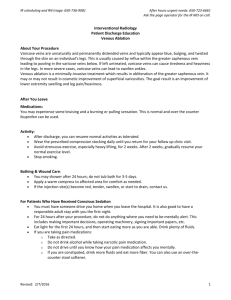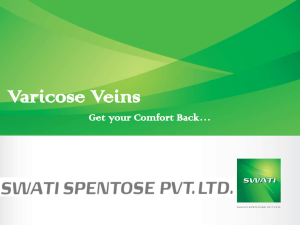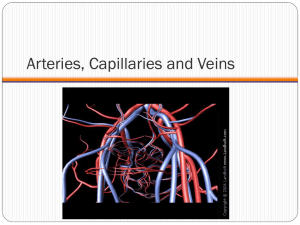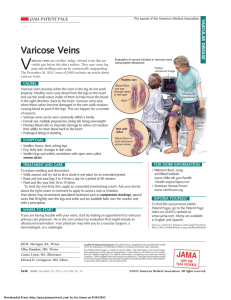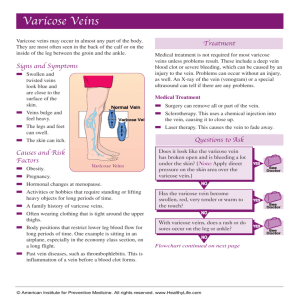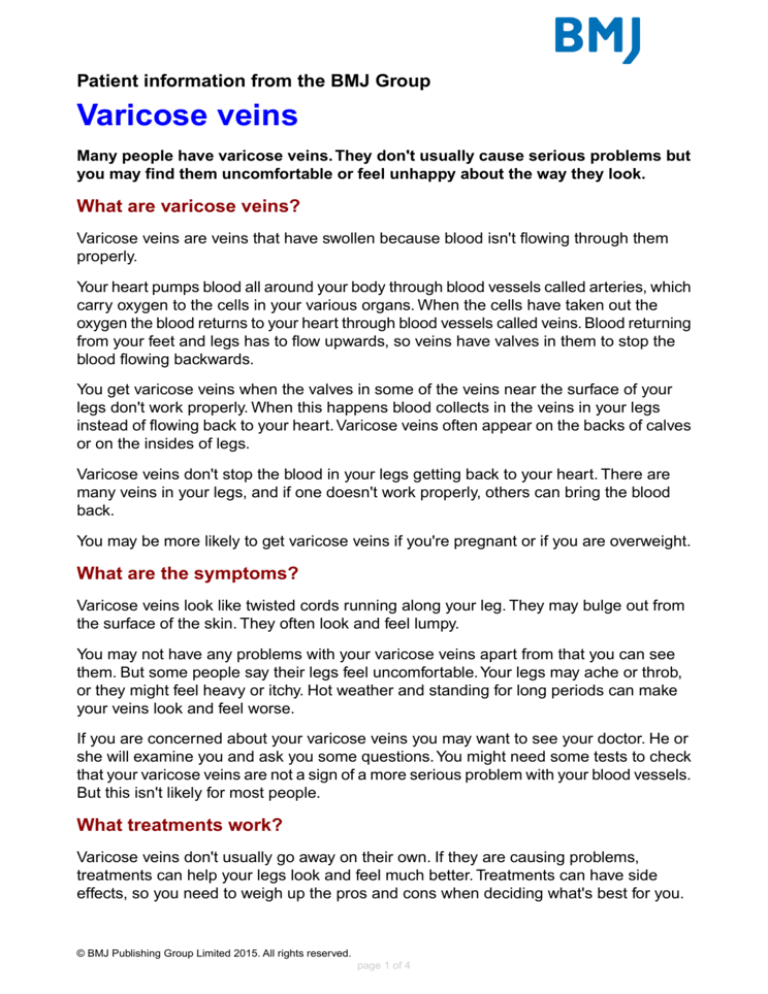
Patient information from the BMJ Group
Varicose veins
Many people have varicose veins. They don't usually cause serious problems but
you may find them uncomfortable or feel unhappy about the way they look.
What are varicose veins?
Varicose veins are veins that have swollen because blood isn't flowing through them
properly.
Your heart pumps blood all around your body through blood vessels called arteries, which
carry oxygen to the cells in your various organs. When the cells have taken out the
oxygen the blood returns to your heart through blood vessels called veins. Blood returning
from your feet and legs has to flow upwards, so veins have valves in them to stop the
blood flowing backwards.
You get varicose veins when the valves in some of the veins near the surface of your
legs don't work properly. When this happens blood collects in the veins in your legs
instead of flowing back to your heart. Varicose veins often appear on the backs of calves
or on the insides of legs.
Varicose veins don't stop the blood in your legs getting back to your heart. There are
many veins in your legs, and if one doesn't work properly, others can bring the blood
back.
You may be more likely to get varicose veins if you're pregnant or if you are overweight.
What are the symptoms?
Varicose veins look like twisted cords running along your leg. They may bulge out from
the surface of the skin. They often look and feel lumpy.
You may not have any problems with your varicose veins apart from that you can see
them. But some people say their legs feel uncomfortable. Your legs may ache or throb,
or they might feel heavy or itchy. Hot weather and standing for long periods can make
your veins look and feel worse.
If you are concerned about your varicose veins you may want to see your doctor. He or
she will examine you and ask you some questions. You might need some tests to check
that your varicose veins are not a sign of a more serious problem with your blood vessels.
But this isn't likely for most people.
What treatments work?
Varicose veins don't usually go away on their own. If they are causing problems,
treatments can help your legs look and feel much better. Treatments can have side
effects, so you need to weigh up the pros and cons when deciding what's best for you.
© BMJ Publishing Group Limited 2015. All rights reserved.
page 1 of 4
Varicose veins
Many people have surgery to remove their varicose veins. But your doctor will probably
suggest you try a few simple things first to see if they help. These could include:
•
Wearing support stockings, which are tight around your lower legs, may reduce
swelling and aching in your legs. These stockings are designed to help the veins
squeeze the blood back up your legs. It's important to be sure you have the right
type of stockings and that they fit well. Talk to your pharmacist or doctor about getting
the right type.
•
Keeping to a healthy weight may help reduce the pressure on your veins.
•
Exercise such as running or walking may help your veins pump the blood around
your legs better.
•
If your legs ache, try resting with your legs higher than your heart – for example,
lying down with your legs up on cushions. Avoid standing or sitting for long periods
if possible.
•
Stop smoking. Smoking damages blood vessels, so it's possible that stopping
smoking could help with the symptoms.
If these things don't help, your doctor may suggest trying other treatments. Surgery used
to be the most common treatment for varicose veins. But other procedures are becoming
more popular as we learn more about them. The main treatments available are explained
below.
Surgery
Having surgery can get rid of your varicose veins. It is likely to improve the way your legs
look and also help symptoms like aching or heavy and tired legs.
There are several ways to do this operation, but in the most common one the surgeon
ties off and strips out the vein or veins causing your symptoms. It's often done through
two cuts in your leg: one at your groin and the other at the inside of your knee, or your
ankle. The surgeon first ties the vein near your groin, then removes it through the cut
further down.
You'll probably be able to go home the same day as your surgery but you will need time
off from your normal activities to recover. Recovering from surgery for varicose veins
can be painful. Your legs may feel sore for several weeks.
Like any operation, surgery for varicose veins has some risks. Problems can include
having an allergic reaction to the anaesthetic, bleeding heavily during or soon after the
operation, bruising, and having numb patches on your legs.
More serious problems can sometimes happen. For example, sometimes a blood clot
can develop in the deep veins of your leg. Doctors call this deep vein thrombosis (DVT).
© BMJ Publishing Group Limited 2015. All rights reserved.
page 2 of 4
Varicose veins
This is dangerous. If you have a high risk of getting blood clots you may be given small
doses of blood-thinning drugs.
If the big nerve that runs down the back of your thigh is damaged it can make your foot
floppy and weak. Doctors call this foot drop. One study found that it happened to 1 in
600 people who had surgery for varicose veins.
Very rarely, surgery goes wrong and damages deeper veins. This may make your
problems with blood flow worse. You may need more surgery to put this right.
Radiofrequency ablation
Radiofrequency ablation uses heat to close up varicose veins. A tube called a catheter
is inserted into the vein. A device threaded through the catheter then emits radiofrequency
energy, which heats the vein and seals it off.
This technique is becoming more widely used as research suggests that it works just as
well as surgery, with a shorter and less painful recovery.
Laser treatment
With laser treatment a catheter is threaded through a small hole in your skin into the
vein. A laser is then placed in the tube. The intense light from the laser heats your vein
and makes it close up.
This procedure is becoming more widely used, for the same reasons that radiofrequency
ablation is becoming more popular
Injections
Having injections of chemicals into your varicose veins may get rid of them. The injections
make the blood vessels collapse so blood can't get through them. Doctors call these
injections sclerotherapy. They are often used to clear up remaining varicose veins after
surgery.
Your veins will probably look better after injections. But there's not much good research
to say whether injections can help with other symptoms like aching.
Injections can have side effects. Your skin may look discoloured afterwards. This can
take a while to go away. Injections may not work as well as having surgery to remove a
vein. Varicose veins are more likely to come back after injections than after surgery.
Some people say the injections hurt. About 30 in 100 people get an itchy rash with swollen
circles at the spot where the needle went in. But this is temporary. Some people also get
bruising, swelling, and red skin patches after injections. But injections are likely to be
less painful than surgery.
What will happen to me?
Without treatment varicose veins tend to get worse over the years. This normally happens
very slowly. You may also get more varicose veins in your legs over time.
© BMJ Publishing Group Limited 2015. All rights reserved.
page 3 of 4
Varicose veins
Varicose veins do not usually disappear on their own. But if you get varicose veins while
you are pregnant they may disappear after you have your baby.
Older people sometimes find that they get other problems linked to their varicose veins.
These include thin, dry, itchy skin over the veins. Bumping a vein can be painful and can
lead to bleeding. And small blood clots can build up in varicose veins. This can be sore
and can make the vein swell. You should see your doctor if this happens. Less often,
the skin near varicose veins gets broken. This is called an ulcer and needs treatment.
Some people worry that they will get deep vein thrombosis (DVT) because of their varicose
veins.This is when a big blood clot develops in your deep veins, which can be dangerous.
But there is no good evidence that having varicose veins leads to DVT.
This information is aimed at a UK patient audience. This information however does not replace medical advice.
If you have a medical problem please see your doctor. Please see our full Conditions of Use for this content. These
leaflets are reviewed annually.
© BMJ Publishing Group Limited 2015. All rights reserved.
Last published: Nov 06, 2015
page 4 of 4



